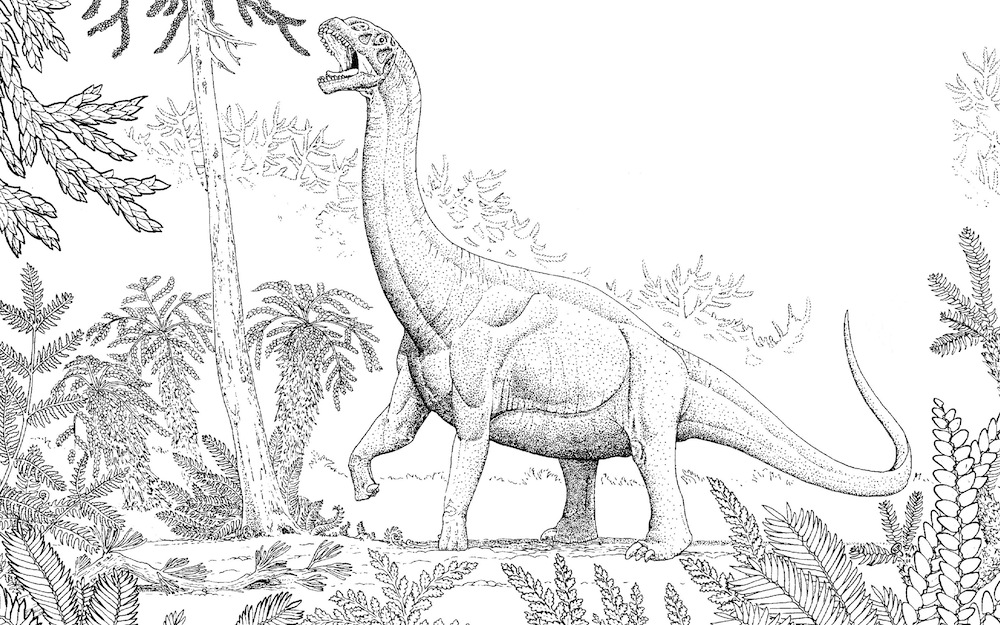Cool News: Dinos May Have Been Warm-Blooded

The long-necked, lumbering Brachiosaurus that wandered the Earth150 million years ago ran a body temperature cooler than scientists had thought. The beasts most likely had special cooling mechanisms or behaviors to keep their temperatures down, a new study suggests.
These plant-eating dinosaurs, called sauropods — the largest animals ever to walk the Earth — probably had temperatures more like humans today, from around 96 degrees Fahrenheit to 100.8 F (roughly 35 to 38 degrees Celsius).
"Birds evolved from dinosaurs. We know modern birds are warm-blooded but we don't know at what point that evolved," said study researcher Rob Eagle of Caltech University. "This was the first quantitative measure of the body temperature of a dinosaur." (Warm-blooded mammals try to maintain their bodies at a constant temperature, whereas cold-blooded creatures take on the temperature of their surroundings.)
Toothy temperatures
The researchers tested several sauropod teeth, from two different species, for carbon-13 and oxygen-18, which are isotopes (atoms of the same element with different numbers of neutrons). How often these isotopes bond to each other, or clump together, depends on temperature; the lower the temperature, the more the isotopes clump together. By measuring this clumping the researchers could estimate the temperature where they formed, in this case, inside the dinosaur. They developed the method by testing it on modern animals of every kind, including primates and reptiles.
"We could accurately reconstruct the body temperature of modern organisms," Eagle told LiveScience. "We used the same approach on samples of dinosaur teeth that are 150 million years old." [25 Amazing Ancient Beasts]
They found that the dinosaurs came in at around the same body temperature as humans. The Brachiosaurus had a temperature of about 100.8 degrees Fahrenheit (38.2 degrees Celsius) and the Camarasaurus had one of about 96.3 degrees Fahrenheit (35.7 degrees Celsius).
Sign up for the Live Science daily newsletter now
Get the world’s most fascinating discoveries delivered straight to your inbox.
Big, hot dinos
This new evidence seems to support the idea that dinosaurs weren't cold-blooded like today's lizards and reptiles. It's possible that their large size made them warm just from the heat of their metabolism, the so-called "gigantotherm" theory.
Calculations based on size indicate that if they were gigantotherms, the dinos should be running even warmer than their teeth indicate — up to 113 degrees F (45 degrees C). "The numbers we measured suggest that sauropods may have had some ability to regulate their body temperatures, and cooling might have been the biggest issue for these animals," Eagle said.
Researchers believe that the dinosaurs probably had some behavioral or bodily mechanisms to cool themselves down. They could have stayed mostly in the shade, or decreased their metabolism when they reached adult size.
By looking at samples from other dinosaurs, including dwarf and juvenile versions of the sauropods, the researchers hope to determine more about the animal's metabolism and body temperature.
The study will be published today (June 23) in the journal Science.
You can follow LiveScience staff writer Jennifer Welsh on Twitter @microbelover. Follow LiveScience for the latest in science news and discoveries on Twitter @livescience and on Facebook.
Jennifer Welsh is a Connecticut-based science writer and editor and a regular contributor to Live Science. She also has several years of bench work in cancer research and anti-viral drug discovery under her belt. She has previously written for Science News, VerywellHealth, The Scientist, Discover Magazine, WIRED Science, and Business Insider.










